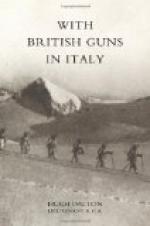Of Palmanova I will write again. This was the Railhead and the Ammunition Dump for the British Batteries. I stayed there that day scarcely an hour, and then went on by motor lorry to Gradisca, the Headquarters of “British Heavy Artillery, Italy.” Here I lunched and was well received by the Staff, who were expecting no reinforcements and were astonished at my coming. It was decided, after some discussion, to attach me temporarily to a Battery which had one officer in hospital, slightly wounded by shrapnel. I continued my journey in another motor lorry after lunch. Gradisca lies on the western bank of the Isonzo, which is crossed close by at Peteano by a magnificent broad wooden bridge, the work of Italian engineers. Gradisca had not been badly damaged, the Austrians having made no great resistance here against the Italian advance in May 1915, but Peteano had been laid absolutely flat by Austrian twelve-inch guns. It had been utterly destroyed in half an hour’s intense bombardment some months before, and many Italian hutments in the neighbourhood had been destroyed at the same time.
Within sight of this bridge, at a distance of a quarter of a mile, is the confluence of the Vippacco with the Isonzo. From this point the road follows the Vippacco to Rubbia, the Headquarters of Colonel Raven, who commanded the Northern Group of British Batteries. which I was now joining. The five Batteries of this Group, known as “B2,” were all in positions on or near the Vippacco, firing on the northern edge of the Carso, and eastward along the river valley. The southern Group, “B1,” were on the Carso itself and operating chiefly against the famous Hermada, a position of tremendous natural strength, directly covering Trieste. B2 had the more comfortable and better-shaded positions, but B1, though their guns were among the rocks and in the full heat of the sun, were in easy reach of the sea, and had a Rest Camp at Grado among the lagoons.
Raven’s Group, B2, formed part of an Italian Raggruppamento, or collection of Groups, under the command of a certain Sicilian Colonel named Canale, a dapper little man who generally wore white gloves, even in the front line. He was a fearless and capable officer and did all in his power for the comfort of our Batteries.
From Rubbia I drove in a car to the Battery. As I left the Group Headquarters, a number of wooden huts at the foot of the wooded slopes of Monte San Michele, which rise upwards from the road, I went under the railway which in peace-time connects Gorizia with Trieste. It is useless now, being within easy range of the Austrian guns, which have, moreover, broken down the high stone bridge on which the line crosses the Vippacco. A young Sicilian Sergeant accompanied me as a guide and pointed out Gorizia, some six miles away to the north, a widely-scattered town, very white in the sunlight, lying at the foot of high hills famous in the history of the war on this Front, Monte Sabotino, Monte Santo, Monte San Gabriele, of which there will be more for me to say hereafter.




